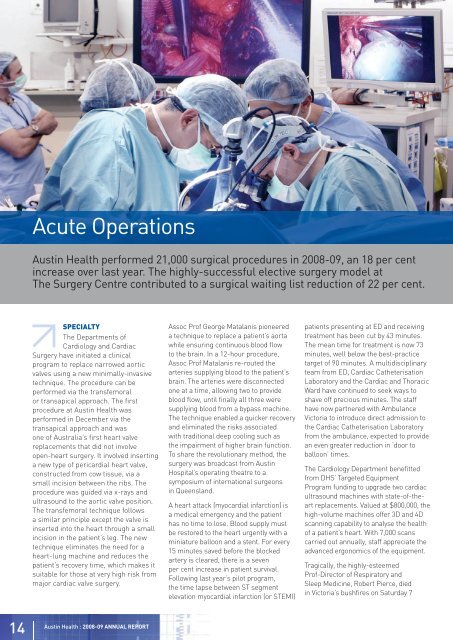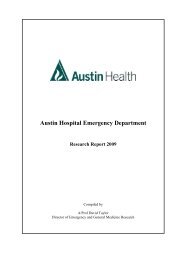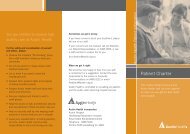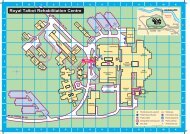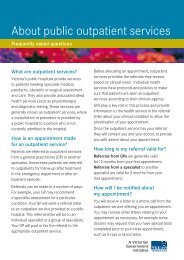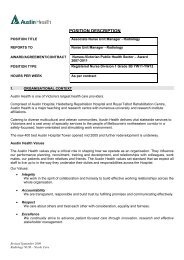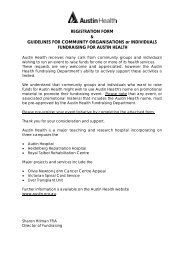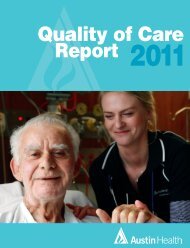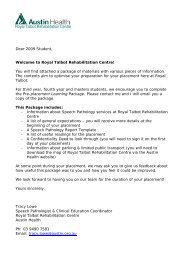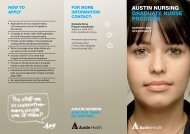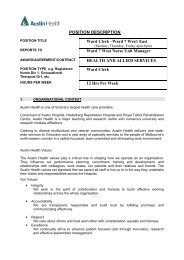Annual Report 2008-09 - Austin Health
Annual Report 2008-09 - Austin Health
Annual Report 2008-09 - Austin Health
Create successful ePaper yourself
Turn your PDF publications into a flip-book with our unique Google optimized e-Paper software.
Acute Operations<br />
<strong>Austin</strong> <strong>Health</strong> performed 21,000 surgical procedures in <strong>2008</strong>-<strong>09</strong>, an 18 per cent<br />
increase over last year. The highly-successful elective surgery model at<br />
The Surgery Centre contributed to a surgical waiting list reduction of 22 per cent.<br />
SPECIALTY<br />
The Departments of<br />
Cardiology and Cardiac<br />
Surgery have initiated a clinical<br />
program to replace narrowed aortic<br />
valves using a new minimally-invasive<br />
technique. The procedure can be<br />
performed via the transfemoral<br />
or transapical approach. The first<br />
procedure at <strong>Austin</strong> <strong>Health</strong> was<br />
performed in December via the<br />
transapical approach and was<br />
one of Australia’s first heart valve<br />
replacements that did not involve<br />
open-heart surgery. It involved inserting<br />
a new type of pericardial heart valve,<br />
constructed from cow tissue, via a<br />
small incision between the ribs. The<br />
procedure was guided via x-rays and<br />
ultrasound to the aortic valve position.<br />
The transfemoral technique follows<br />
a similar principle except the valve is<br />
inserted into the heart through a small<br />
incision in the patient’s leg. The new<br />
technique eliminates the need for a<br />
heart-lung machine and reduces the<br />
patient’s recovery time, which makes it<br />
suitable for those at very high risk from<br />
major cardiac valve surgery.<br />
Assoc Prof George Matalanis pioneered<br />
a technique to replace a patient’s aorta<br />
while ensuring continuous blood flow<br />
to the brain. In a 12-hour procedure,<br />
Assoc Prof Matalanis re-routed the<br />
arteries supplying blood to the patient’s<br />
brain. The arteries were disconnected<br />
one at a time, allowing two to provide<br />
blood flow, until finally all three were<br />
supplying blood from a bypass machine.<br />
The technique enabled a quicker recovery<br />
and eliminated the risks associated<br />
with traditional deep cooling such as<br />
the impairment of higher brain function.<br />
To share the revolutionary method, the<br />
surgery was broadcast from <strong>Austin</strong><br />
Hospital’s operating theatre to a<br />
symposium of international surgeons<br />
in Queensland.<br />
A heart attack (myocardial infarction) is<br />
a medical emergency and the patient<br />
has no time to lose. Blood supply must<br />
be restored to the heart urgently with a<br />
miniature balloon and a stent. For every<br />
15 minutes saved before the blocked<br />
artery is cleared, there is a seven<br />
per cent increase in patient survival.<br />
Following last year’s pilot program,<br />
the time lapse between ST segment<br />
elevation myocardial infarction (or STEMI)<br />
patients presenting at ED and receiving<br />
treatment has been cut by 43 minutes.<br />
The mean time for treatment is now 73<br />
minutes, well below the best-practice<br />
target of 90 minutes. A multidisciplinary<br />
team from ED, Cardiac Catheterisation<br />
Laboratory and the Cardiac and Thoracic<br />
Ward have continued to seek ways to<br />
shave off precious minutes. The staff<br />
have now partnered with Ambulance<br />
Victoria to introduce direct admission to<br />
the Cardiac Catheterisation Laboratory<br />
from the ambulance, expected to provide<br />
an even greater reduction in ‘door to<br />
balloon’ times.<br />
The Cardiology Department benefitted<br />
from DHS’ Targeted Equipment<br />
Program funding to upgrade two cardiac<br />
ultrasound machines with state-of-theart<br />
replacements. Valued at $800,000, the<br />
high-volume machines offer 3D and 4D<br />
scanning capability to analyse the health<br />
of a patient’s heart. With 7,000 scans<br />
carried out annually, staff appreciate the<br />
advanced ergonomics of the equipment.<br />
Tragically, the highly-esteemed<br />
Prof-Director of Respiratory and<br />
Sleep Medicine, Robert Pierce, died<br />
in Victoria’s bushfires on Saturday 7<br />
14<br />
<strong>Austin</strong> <strong>Health</strong> : <strong>2008</strong>-<strong>09</strong> ANNUAL REPORT


